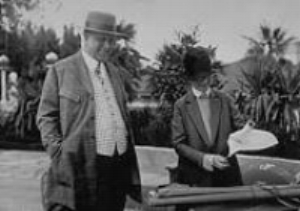These recollections of early Sausalito are excerpted from the unpublished work of an unknown author, who appears to have written them sometime in the early 1960s. As in last week’s excerpt, what follows is a knowledgeable, often gossipy, sometimes inaccurate account, of people, places and events in Sausalito before and after the turn of the century.
Julia Morgan, who designed Hearst Castle at San Simeon, also worked with Willie Hearst on his plans for a Sausalito castle.
Courtesy Photograph.
Sausalito used to be a happy family. The County Road, beautiful among its woods and unspoiled roadsides, wound along the base of the hills. It was beautiful Marin in those days. There were of course no pavements, no gas, no electricity. In the winter; rubbers were a necessity and you were lucky if you didn't leave them in a hole.
These were the happy days before the Pool Rooms came. The Hill and the Waterfront got along together. Then San Francisco closed its pool rooms, (i.e., places that existed for betting on the races) and they moved in mass to Sausalito. The waterfront changed. There were 25 saloons, almost as many pool rooms, to a community of 1000 people.
On the days of the races the Ferry Boats were crowded to standing room only with an undesirable crowd. On race days a decent woman didn't like to pass through Water Street, now Bridgeway, to get to the Ferry. The whole downtown smelled of stale beer. There was a large mud hole between the Ferry and the other side of the street with a bouncy plank on it. Long skirts, high collars, long sleeves, hats pinned on with long hat-pins — It was something to navigate.
The Hill was inhabited by people of the Bank President, successful Lawyer class, who lived here because they like quiet and the country, and who had big houses in the midst of big pieces of ground — and isn't it a pity that the Zoning Commission didn't get the idea of large building lots before these lovely estates were cut up and built upon! Imagine their wrath.
In those happy days anybody could vote who had been two weeks in a community. The saloon or waterfront element imported stew bums and barflies, fed them, gave them all they wanted to drink and voted them.
There was no fire department in those days. The first one who could make Christ Church rang the bell. Anna Sperry was the champion. Then all the women went to the fire and carried out possessions and guarded them from souvenir hunters. Wullie Corson, black eyes flashing, in his beautiful Edinburgh accent, said, "If ever my house catches fire I'll stand in the front door and shoot everybody that tries to come in — I supply no souvenirs."
Everybody had to have a water tank on top of the house as the water was turned off at nine o'clock in the morning and not turned on until five in the afternoon. The uninformed and un-provided got the shock of their lives when they tried to wash cloths on Monday morning. The roof tanks were useful in time of fire. When Mr. Berg's house on Bulkley Avenue, across from
the Tillinghast front yard, burned, about 1903, Willie Harrison and Clay Miller on the roof of Yellow Jacket, close to Mr. Berg's house, saved it by soaking bed comforters in the tank and hanging them over the edge of the house. The north side of the town was supplied from the spring in Wildwood Glen. The Sausalito Bay Land Company serviced the south side, Old Town, with water tunnels, still to be seen along Sausalito Blvd.
The first club, not a woman's club, was in the old H.C. Campbell house, where Mrs. Petherick now lives. It was called the "Lantern Club". If you went out at night you carried a lantern.
The Catholic church was in New Town, as the North side of town was always known.
Christ Church began in the loft of the Shoobert's barn, on the corner of Harrison and Santa Rosa. The rector kept a cow and a horse down below and moos sometimes interrupted the service.
Oh, the wide open spacious days of old, when there were patches of woodland and wild flowers grew everywhere. "Red Gables" and the old stables; later converted into a house, were the only buildings on the property between Spencer, Miller Avenue and San Carlos Avenue. Where there used to be one house there are now at least seven.
The massive masonry on the upper side of Bridgeway, that everybody wants to know about was built by William Randolph Hearst with some grandiose plan for a castle. But after he was invited to leave town by a delegation of the husbands and fathers of the Hill, he stopped building. He continued to buy property until he owned everything from the "Hacienda" across Bulkley Avenue from the "O'Connell Seat" all the way to North Street. Sausalito was on edge, knowing Willie Hearst to be vindictive. Willie Hearst, who always had a special lady, after his gay weekend parties left her in command. He had a launch and could go and come as he liked. The Lady, a striking blond; walked the roads and was seen and passed by the mothers and daughters of the blessed. In those days a respectable woman was not supposed to breathe the same air as a fancy lady. The fathers were indignant. For Old Timers, Willie Hearst was a bad word. He and his millions held no terrors for men themselves well to do and well established. There is a wonderful little book, "Imperial Hearst", by a newspaper man, an ex-employee of the Examiner who knew all and told all but the Sausalito Father's Episode. Too bad he didn't know that too! It is picturesque.

